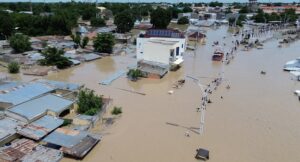The Federal Executive Council (FEC) has taken a significant step towards addressing the increasing frequency of natural disasters in Nigeria by approving the establishment of a Disasters Relief Fund. This fund is designed to provide swift and effective responses to victims of disasters across the country, ensuring that those affected by floods, fires, and other natural calamities receive the immediate aid they need.
The announcement was made on Monday by Wale Edun, the Minister of Finance and Coordinating Minister of the Economy, during a briefing with State House Correspondents shortly after the FEC meeting, which was chaired by President Bola Tinubu at the Presidential Villa in Abuja. According to the minister, the fund will draw resources from a combination of government tiers – federal, state, and local – as well as private sector stakeholders. The goal is to pool finances from these various sources to provide timely relief to disaster victims, particularly those affected by the recent and devastating floods that have ravaged parts of the country.
 Flooding has become an annual concern in Nigeria, affecting large portions of the population and causing extensive damage to homes, farmlands, and infrastructure. In light of this, the FEC has also constituted a Technical Committee tasked with reassessing the country’s dams, with a particular focus on the Alau Dam in Borno State. This comes after devastating floods in Maiduguri, the capital of Borno, which resulted in the loss of dozens of lives and the destruction of thousands of homes. The committee, which will be chaired by the Minister of Water Resources, has been given the responsibility of evaluating the safety and functionality of dams across the nation, with a view to preventing future disasters linked to dam failures or overflows.
Flooding has become an annual concern in Nigeria, affecting large portions of the population and causing extensive damage to homes, farmlands, and infrastructure. In light of this, the FEC has also constituted a Technical Committee tasked with reassessing the country’s dams, with a particular focus on the Alau Dam in Borno State. This comes after devastating floods in Maiduguri, the capital of Borno, which resulted in the loss of dozens of lives and the destruction of thousands of homes. The committee, which will be chaired by the Minister of Water Resources, has been given the responsibility of evaluating the safety and functionality of dams across the nation, with a view to preventing future disasters linked to dam failures or overflows.
The tragic flooding in Maiduguri highlights the urgency of such initiatives. Just recently, the overflowing Alau Dam claimed the lives of over 30 people and displaced thousands of residents. This incident has raised concerns about the state of Nigeria’s water infrastructure and the need for a more comprehensive approach to managing the risks posed by dams, especially during periods of heavy rainfall.
To further mitigate the risk of flooding, the Federal Government, through the Nigeria Hydrological Services Agency (NIHSA), has proposed the construction of five buffer dams. These dams are intended to help manage and contain the frequent flooding that occurs as a result of the annual release of water from the Lagdo Dam in neighboring Cameroon. Each year, the release of excess water from the Lagdo Dam leads to significant flooding in several Nigerian states, causing widespread damage and displacement. The buffer dams would act as reservoirs to absorb this excess water, significantly reducing the impact of floods on downstream communities.
NIHSA has also issued warnings to Nigerians residing in flood-prone areas, particularly those living near rivers or low-lying regions, to relocate to safer areas in anticipation of the flooding that typically accompanies the Lagdo Dam’s annual water release. The agency’s warning is critical, given that the flood season is fast approaching, and the likelihood of severe flooding remains high.
Some of the states at greatest risk include Adamawa, Taraba, Benue, Nasarawa, Kogi, Edo, Delta, Anambra, Bayelsa, Cross River, and Rivers. These areas have consistently been hit hard by floods, leaving thousands of people displaced and causing extensive damage to agricultural lands, homes, and infrastructure. The federal government’s call for residents to relocate is a proactive measure to reduce the potential loss of life and property during the upcoming flood season.
In addition to urging residents to relocate, the government is also looking at long-term solutions to prevent and manage future floods. The proposed buffer dams, along with the comprehensive reassessment of existing dams, represent a strategic approach to flood management in Nigeria. By improving infrastructure and implementing preventive measures, the government aims to significantly reduce the impact of floods, which have become an annual crisis for many communities across the country.
The establishment of the Disasters Relief Fund, alongside these infrastructural projects, shows a commitment by the current administration to not only respond to disasters as they happen but also to take proactive steps in preventing future occurrences. The fund will play a vital role in ensuring that the necessary resources are readily available to support disaster victims without the delays often associated with bureaucratic processes.
President Tinubu’s administration has made it clear that disaster management and response are top priorities, especially as climate change continues to exacerbate the frequency and intensity of natural disasters like flooding. The government’s focus on collaboration between various levels of government and the private sector also highlights the understanding that disaster relief and management require collective effort and shared responsibility.
In conclusion, the FEC’s approval of the Disasters Relief Fund and the reassessment of Nigeria’s dams are timely and necessary measures. These actions not only aim to provide immediate relief to victims but also to establish a more robust and long-term framework for managing natural disasters in the country. As Nigeria faces increasing challenges from climate-related disasters, these initiatives offer hope for better preparedness and resilience, ensuring that communities are not only protected but also able to recover quickly when disasters strike.




